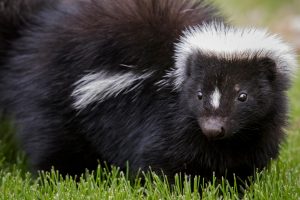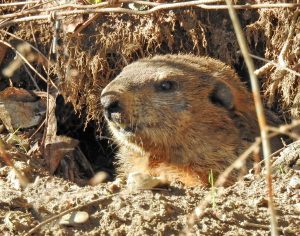
“What’s in a name? That which we call a rose by any other name would smell as sweet.”
In this famous line from Romeo and Juliet (II, ii, 1-2), William Shakespeare’s tale of the “star-cross’d” lovers, Juliet is telling Romeo that his last name isn’t important, and that she didn’t care that their families were feuding, as a name is a man-made and meaningless convention. Some might argue that Juliet is right. No matter what we name or call something, it does not change what that plant or animal is. However, we still need to be able to talk about them in a way that everyone understands.
WHEN IS A WOODCHUCK NOT A WOODCHUCK?
When you look at some of the different names that we use for wildlife, some people might agree that the names we give don’t always make sense, at least not at surface level. On top of that, an animal might have several different colloquial names. Take for example, the woodchuck: it is also known as a groundhog, whistle pig, marmot, grass rat, and earth pig depending on where you live. If the names we give something aren’t even reliable within Ohio, how can we be sure when we talk to someone else that we are talking about the same animal, especially across different languages and cultures?
That can be especially tough for those of us who work with visitors from other countries, in my case the Spanish-speaking population of Columbus. The names that are used for different organisms can vary wildly from region to region, and country to country.
KINGS & SPAGHETTI LEAD THE WAY
In steps Carl Linnaeus, a Swedish botanist, physician, and zoologist. In the 18th century, he developed a system of taxonomic nomenclature to help classify organisms. He devised the system of using a nested hierarchy, starting with Kingdoms, then moving to Classes, Orders, Genera (singular: genus), and then divided into Species. He would sometimes recognize a lower division, which then have standardized into Variety in botany and Subspecies in zoology. Although this system has changed over time, adding family between order and genus and phylum between kingdom and class, this organizational strategy has helped scientists and citizens throughout the world understand each other and make sure they were talking about the same organism. His classifications were based on physical similarities, while we now often use genetics to determine relationships. If this sounds familiar, perhaps you’ve heard of the mnemonic device “King Philip Came Over For Good Spaghetti” or something similar. This is a memorization tool for “Kingdom, Phylum, Class, Order, Family, Genus, Species.”
THERE ARE MORE THAN 11-MILLION HOMO SAPIENS IN OHIO
Maybe you’ve heard of some of these scientific names being used. For example, you may have heard of Homo sapiens, the scientific term used to describe humans. Perhaps you’ve learned one of the easiest to remember, the American bison’s scientific name: Bison bison. How do these names come about, and why do some of them sound so funny? Linnaeus mainly used Latin in his naming, and some Greek has been used as well. Most of these organisms’ scientific names describe an attribute of the organism, or are named after a famous scientist or the scientist who described the organism. More recently, scientists have been more creative in naming organisms, naming some after people such as actor Harrison Ford, performer Beyoncé, and fictional characters such as Darth Vader.

SCIENCE IS A WHOLE OTHER LANGUAGE
Let’s take a look at some of scientific names for the native Ohio animals that we find in the Metro Parks, starting with one of our most famous, the striped skunk, Mephitis mephitis. What are they famous for? Being rather odiferous, of course. That’s why their scientific name translates to “bad odor, bad odor,” or as I like to think about it, “stinky, stinky.” Speaking of stinky, have you heard of the common puffball, Lycoperdon perlatum? It’s a very interesting fungi that when touched will release spores, which inspired its genus, which translates: lyco = wolf, and perdon = farts. Many other scientific names also make sense, such as the species name for the longear sunfish, megalotis, which means “big ears.” Anas acuta means sharp-pointed duck (it’s the northern pintail); Glaucomys volans is the southern flying squirrel (glaukos = gray, mys = mouse, volans[greek] = flying); the gadwall is Anas strepera. Anas = duck, strepera = noisy. The big brown bat also makes sense, Eptesicus fuscus. Eptesicus is Latin for “house flier,” fuscus is Latin for “brown.”

IT’S ALL GREEK TO ME
Latin and greek aren’t the only roots used. When you consider the aforementioned woodchuck, Marmota monax, you see the Latin for “marmot” or “groundhog,” followed by monax, an American Indian name for the woodchuck that means “the digger.” But even the scientific name can sometimes be confusing, such as with the eastern mole, Scalopus aquaticus. In Greek, skalops means “to dig,” and pous means “foot,” which makes sense for an animal that digs with its feet. However, once you combine that with the Latin aquaticus, or “water dweller,” you’d think that the eastern mole likes to live in water, which usually isn’t the case. Linnaeus (who named thousands of organisms) probably named it because of its webbed feet and where he found it, and not because of where it lives. So there are times that scientists can get it wrong, too.
COMMON NAMES IN FOREIGN LANGUAGES
When it comes down to talking to people in other languages, whether it’s Greek, Swahili, Urdu, Russian, Spanish or anything else, scientific names shine. Since the common name might not translate directly, having the scientific name allows somebody to look it up and find out what that plant or animal is called in the other language. This allows for people to communicate more effectively, knowing that they’re both talking about the same organism. It might seem like too many extra steps, but when accuracy is important, it’s the best way to go.
Now, what happens when an organism doesn’t have a name in the other language? One option is, you guessed it, to use the scientific name.
That’s not all scientific names are useful for, but we’ll leave that for another time. In the meantime, what would you call a rose?
To learn more about how Metro Parks uses scientific names across languages, check out Metro Parks’ Spanish Facebook and Twitter pages @MetroParksESP.
(By Ricardo Granados, Naturalist at Battelle Darby Creek Metro Park)
